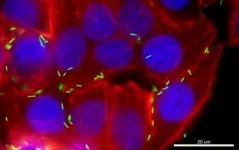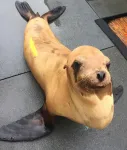(Press-News.org) PULLMAN, Wash. - Washington State University researchers have discovered a protein that could be key to blocking the most common bacterial cause of human food poisoning in the United States.
Chances are, if you've eaten undercooked poultry or cross contaminated food by washing raw chicken, you may be familiar with the food-borne pathogen.
"Many people that get sick think, 'oh, that's probably Salmonella,' but it is even more likely it's Campylobacter," said Nick Negretti ('20 Ph.D.), a lead member of the research team in Michael Konkel's Laboratory in WSU's School of Molecular Biosciences.
According to a study on the research recently published in Nature Communications, a secreted protein known as CiaD facilitates cell entry by Campylobacter and takes control of important cell processes by changing the composition of a protein complex inside the cell.
By gaining insight into the infection process and the specific actions of the Campylobacter secreted proteins, the work gives the WSU team and the rest of the field a foundation to understanding why infections occur and persist.
Until the Konkel Lab's latest finding, the functions of the bacterium's proteins and how they infect the cell were largely unknown.
"We knew these things were happening, but we didn't know how," said Negretti. "Now, if we can stop this process, disease won't happen."
The work was funded by a 5-year, $1.9 million grant from the National Institutes of Health and builds on two decades of research in the Konkel Lab.
Most often known for the nausea, vomiting and bloody diarrhea that comes with it, once ingested, Campylobacter jejuni secretes proteins that infiltrate the cells lining the intestinal tract, which allows it to hide from the immune system.
The bacteria account for 400 to 500 million cases of diarrhea annually, and the World Health Organization recognizes it as a serious threat due to its antibiotic resistance.
The infection is also correlated with stunted linear growth in impoverished children, and in developed countries, a higher incidence of Guillain-Barré syndrome, when the body's immune system attacks the nerves.
The research was a seven-year collaborative effort, using the latest molecular biology and biochemistry methods.
The work was done in partnership with researchers Geremy Clair and Joshua Adkins with the Pacific Northwest National Laboratory. Using mass spectroscopy, Adkins and Clair were able to study protein-to-protein interaction that helped the WSU researchers narrow their focus and uncover the target of CiaD.
Konkel said the research would not have been completed without post-doctoral fellow Prabhat Talukdar and graduate students Courtney Klappenbach and Cody Lauritsen leading the work through its final stretch amid the pandemic.
Now, the researchers are hopeful the work will lead to real-world solutions, in particular finding ways to prevent the pathogen from stunting growth in children.
"With this finding, we can speculate that processes like this that affect the cell could impact the intestinal cell's ability to form the correct structures to absorb nutrients," Negretti said. "While this is a mechanistic level of understanding, the answers to how the bacteria is specifically affecting cells in the body could have broader ranging impacts into understanding the public health importance of this pathogen."
The team also looks forward to learning the functions of other secreted proteins.
A major breakthrough into understanding C. jejuni disease was made in 1999 when the Konkel Lab discovered that proteins are secreted from the bacterium. In 2009, the CiaD protein was identified by Jeffrey Christensen, a post-doctoral fellow in the laboratory.
"We then identified CiaD was delivered to the host cells in 2013," Konkel said. "A major question for the past 20-years has been: what are these secreted proteins and what do they do? This is just the first protein to have an identified cell target."
INFORMATION:
PROVIDENCE, R.I. [Brown University] -- Researchers from Brown University have discovered a previously unknown type of ancient crater lake on Mars that could reveal clues about the planet's early climate.
In a study published in Planetary Science Journal, a research team led by Brown Ph.D. student Ben Boatwright describes an as-yet unnamed crater with some puzzling characteristics. The crater's floor has unmistakable geologic evidence of ancient stream beds and ponds, yet there's no evidence of inlet channels where water could have entered the crater from outside, and no evidence ...
Judges don't do court stenography. CEOs don't take minutes at meetings. So why do we expect doctors and other health care providers to spend hours recording notes -- something experts know contributes to burnout?
"Having them do so much clerical work doesn't make sense," said Lisa Merlo, Ph.D., an associate professor of psychiatry and director of wellness programs at the University of Florida College of Medicine. "In order to improve the health care experience for everyone, we need to help them focus more on the actual practice of medicine."
Physician burnout affects patients, too. Stressed doctors are less compassionate and more likely to make mistakes. Clinicians who leave the field or cut back hours reduce patient access ...
Mount Sinai researchers have found that a widely available and inexpensive drug targeting inflammatory genes has reduced morbidity and mortality in mice infected with SARS-CoV-2, the virus that causes COVID-19. In a study published today in the journal Cell, the team reported that the drug, Topotecan (TPT), inhibited the expression of inflammatory genes in the lungs of mice as late as four days after infection, a finding with potential implications for treatment of humans.
"So far, in pre-clinical models of SARS-CoV-2, there are no therapies--either antiviral, antibody, or plasma--shown to reduce the SARS-CoV-2 disease burden when administered after more than one day post-infection" says senior author Ivan Marazzi, PhD, Associate Professor of Microbiology ...
Research into the diets of a large number of the world's carnivores has been made publicly available through a free, online database created by a PhD student at the University of Sussex.
From stoats in the UK to tigers in India, users are now able to search for detailed information about the diets of species in different geographical locations around the globe.
Created by doctoral student Owen Middleton, CarniDIET is an open-access database which aims to catalogue the diets of the world's carnivores by bringing together past peer-reviewed research. He hopes it will be a useful resource for conservationists and researchers, as well as educators and nature-lovers alike.
Owen said: "There is so much information out ...
A simple plastic water bottle isn't so simple when it comes to the traditional manufacturing process. To appear in its final form, it has to go through a multi-step journey of synthetic procedure, casting, and molding. But what if materials scientists could tap into the same biological mechanisms that create the ridges on our fingertips or the spots on a cheetah in order to manufacture something like a water bottle?
A research paper titled END ...
Preclinical research from VCU Massey Cancer Center published recently in the Proceedings of the National Academy of Sciences shows that the combination of two existing drugs can exploit the metabolic "hunger" of a particularly aggressive type of neuroblastoma to kill cancer cells without inflicting too much collateral damage to healthy tissue.
Neuroblastoma - a type of cancer that strikes the nervous system of very young children - is one of the deadliest pediatric cancers. And children whose neuroblastoma overexpresses the gene MYCN tend to have the worst prognosis.
While medical advancements have led to high cure ...
LOWELL, Mass. - Too often, contends UMass Lowell faculty researcher Brenna Morse, children with complex chronic medical conditions spend days in the hospital undergoing tests for what could be a simple diagnosis.
The challenges include, she says, some children with medical complexities, such as severe neurological conditions and functional impairments, cannot easily signal that they are in pain or point where in their body it is located. Where children not facing such a challenge might be able to have a medical issue resolved with a simple visit to their primary care doctor, others end up hospitalized and going through days of costly testing to arrive at similar diagnoses.
Morse, a UMass Lowell ...
Pink Floyd's Dark Side of the Moon cover, voted the greatest classical rock album of all time, intended to portray the prism and dispersion of light into a rainbow as a certain metaphorical symbolism and a light show that was never celebrated. However, they really were not aware of the fact that this image would be used by many to help illustrate the concept of refractive index and how light changes speed and direction when it encounters a different medium.
Although conceptually the drawing was not accurate, it conveyed the message that light changes its speed when it moves into another medium, and that the different speeds of different colors causes white light to disperse ...
Sausalito, Calif. (March 30, 2021) - After more than three decades of research, scientists have proven that the cancer affecting up to one in four adult California sea lions necrospied at The Marine Mammal Center in Sausalito, CA, is caused by a sexually transmitted herpesvirus. The cancer, known as sea lion urogenital carcinoma, has clear parallels to cervical cancer in humans and provides a helpful model for human cancer study.
Scientists have long suspected this cancer was associated with a virus, but this is the first study to prove this theory. The study, which was published in Animals, an open-access, peer-reviewed journal, concluded that genital herpesvirus is ...
WASHINGTON, March 30, 2021 -- Emerging technologies can screen for cervical cancer better than Pap smears and, if widely used, could save lives both in developing nations and parts of countries, like the United States, where access to health care may be limited.
In Biophysics Reviews, by AIP Publishing, scientists at Massachusetts General Hospital write advances in nanotechnology and computer learning are among the technologies helping develop HPV screening that take the guesswork out of the precancer tests. That could mean better screening in places that lack highly trained doctors and advanced laboratories.
Cervical cancer is the world's fourth-most common cancer, with more than ...









